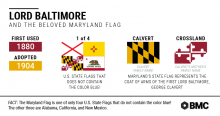You’d be hard-pressed to go anywhere in Maryland without seeing proud residents sporting the arms of the Calvert and Crossland families, which are emblazoned on the state flag, and apparel ranging from sunglasses to socks. Maybe the flag’s popularity is because of its bright colors, busy design, or simply brilliant marketing by the state’s Tourism Board. But we’d like to think that the flag’s popularity has to do with its post-Civil War rebranding, which was intended to reconcile, quite literally, warring neighbors. Either way, its colors and patterns are rooted in the inception of Maryland’s colonial charter, which marks its 386th anniversary on Wednesday, June 20. For the occasion, we dug into our archives to present a brief history of the western world’s founding of the colony of Maryland and it’s appeal to His Royal Highness Charles I, King of England. Hint: The appeal is expansion and trade. Before European subjugation, there is evidence of inhabitants in the area dating back to the ice age. Captain John Smith - yes, the John Smith from the Disney movie - explored the upper Chesapeake in the early 1600s, and encountered many indigenous American Indians. Algonquin tribes claimed most of the land, although both Iroquois and Sioux also maintained a presence. As a result of his exploration, Smith couldn’t help but go on and on about how in awe he was over the beauty of the upper Chesapeake. We’ve hiked along the Patapsco River on a nice fall day, so we totally get the appeal, John. In fact, that’s the reason that William Claiborne, the pioneer and surveyor, first traveled to Virginia and then established a trading post on Kent Island in what’s now Queen Anne’s County. Once trade was established, the nobility and legality followed. George Calvert, the first Lord of Baltimore, explored the Potomac River and Chesapeake Bay, following stints in Newfoundland and Virginia. Calvert originally asked the king for permission to colonize the land south of Virginia, but was met with objections from its people. The king ultimately granted Calvert the land north of Virginia, but he died during the preparation of Maryland’s charter. So the land went to his heir, Cecil Calvert, the second Lord Baltimore. Once the charter’s ink was dry, King Charles I, named the new colony after his wife Queen Henrietta Marie using the name “Terra Mariae,” which means Mary Land. On November 22, 1633, Cecil Calvert set sail for this new colony in two ships - the Ark and the Dove. The ships arrived at the mouth of the Chesapeake at Old Point Comfort three months later, and sailed north to St. Clements Island before negotiating and purchasing land that they named St. Mary’s. At the end of May 1934, the Ark returned to England, leaving the Dove behind to provide transportation for goods – ranging from corn to cod - to be traded up and down the Atlantic seacoast. In August 1635, the Dove sailed back to England with furs and timber to trade, but was never seen again. The Calvert heritage can be seen on both the state seal and state flag. The Calvert colors of gold and black appear opposite the red and white colors of the Crossland family that was the family of the mother of George Calvert. So the next time that you see Maryland’s flag on tank tops or swim trunks, you’ll understand their long history. Sources: Maryland: The Seventh State, A History (Third Edition) – Author: John T. Marck – Creative Impressions, Ltd. 1995 Exploring Maryland’s Roots - http://mdroots.thinkport.org/library/kingqueen.asp Historic St. Mary’s City - https://hsmcdigshistory.org/research/maritime-curation/ark-and-dove/ Maryland Manual Online - https://msa.maryland.gov/msa/mdmanual/01glance/html/symbols/seal.html Maryland Manual Online - https://msa.maryland.gov/msa/mdmanual/01glance/html/symbols/flag.html
Play ball! The Orioles take on the Minnesota Twins this Thursday, March 29, for Opening Day at Camden Yards. With all the excitement of another professional baseball season, we’ve been a bit curious about Camden Yards’ history, so we dug through the Regional Information Center’s archives.The building of Camden Yards Sports Complex was a hot topic right up until they broke ground in 1988. How much money would a brand new ballpark really bring in? Could it ever replace the much-loved Memorial Stadium? Would it attract new sports talent to Baltimore? New fans? This report from 1996 looked at estimates produced by several Maryland departments including the Department of Fiscal Services, the Office of the Governor, and the Baltimore Development Corporation, and then compared them to the actual financial and political impact post-construction. Estimates predicted a 20 percent increase in attendance from the 1991 final season at Memorial Stadium, creating millions of dollars in direct and indirect benefits to the city. Instead, the 1992 Orioles season smashed expectations with a 76 percent increase. Out-of-town visitors flooded in to eat at local restaurants and stay in downtown hotels, boosting revenues from the new stadium even further. Ultimately, visitors came more often and spent more money in Baltimore City. Camden Yards was built as a baseball-only field in order to keep the Orioles franchise interested. After much debate and negotiation, a football stadium was built as part of the Camden Yards Sports Complex in order to attract a football franchise back to Baltimore. Many of the stadium’s supporters used the results of Camden Yards to show how successful the football stadium could be. The Camden Yards ballpark itself became an example of the potential success of future sports projects. The Ravens played their first two years in Baltimore at the old Memorial Stadium before moving to M&T Bank Stadium for the 1998 season. The Baltimore Sun reported in 2017 that during the 2014 and 2015 seasons, spending associated with games averaged $331.3 million and state tax revenue generated approximately $22.5 million. So however you play it, constructing Camden Yards turned out to be a home run for Baltimore!


